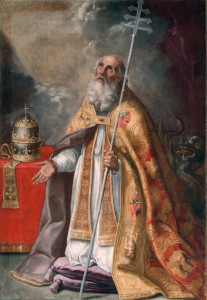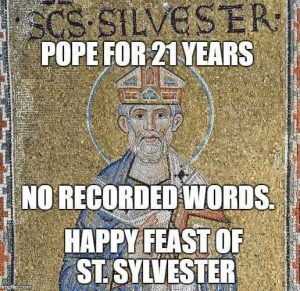Tag: St Sylvester
Saint Sylvester
 The final day of the calendar year has us commemorating the Roman born pope Saint Sylvester (280-335). He was an ardent defender of Catholic faith (making him a confessor of the faith) in a period of harsh trial. Elected bishop of Rome, Sylvester served in that capacity for 21 years. We learn from him the truth of Ubi Petrus, ibi ecclesia: Where Peter is, there the Church is.
The final day of the calendar year has us commemorating the Roman born pope Saint Sylvester (280-335). He was an ardent defender of Catholic faith (making him a confessor of the faith) in a period of harsh trial. Elected bishop of Rome, Sylvester served in that capacity for 21 years. We learn from him the truth of Ubi Petrus, ibi ecclesia: Where Peter is, there the Church is.
In this era of a lack historical awareness, Pope Sylvester is remembered for the Council of Nicea, the Baptism of Constantine, and the triumph of the Church. Some dispute the date of Constantine’s conversion to Christ but apparently there are sources that attest to his Baptism during this papacy. We know that with his acceptance of Jesus as Lord and Savior the Edict of Milan in 313 was created and the rest is history.
Saint Sylvester
 On this final day of the civil year Mother Church honors the memory of Pope Saint Sylvester, who guided the Church with his teaching and life during the persecutions of Diocletian, and during the period of Arianism and the Council of Nicæa. That his feast day is so close to Christmas ought to indicate to us that he had concern for the Christology of Catholic belief and life.
On this final day of the civil year Mother Church honors the memory of Pope Saint Sylvester, who guided the Church with his teaching and life during the persecutions of Diocletian, and during the period of Arianism and the Council of Nicæa. That his feast day is so close to Christmas ought to indicate to us that he had concern for the Christology of Catholic belief and life.
Pope Sylvester’s pontifical ministry saw the construction of great churches in Rome by Constantine, namely the basilica and baptistery of the Lateran near the former imperial Lateran palace where the pope lived (he now resides at the Vatican), the basilica of the Sessorian palace (the Basilica of Santa Croce where the relics of the holy passion are located), the first Church of St. Peter on Vatican Hill, and several cemeterial churches over the graves of martyrs.
More to the point for this blog, and the desire to live in a theology of communion, the sainted Pope contributed to the development of the sacred Liturgy of the Roman Church and drew together the first martyrology of Roman martyrs. Moreover, Sylvester established of the Roman school of chant and music.
Pope Saint Sylvester is buried at the Church connected with the Catacomb of Priscilla.
Saint Sylvester, pope
 The feast day of Saint Sylvester, located so close to the Christmas liturgical cycle was an early decision of the Fathers of the Church, but it has no relation to the Mystery of the Incarnation. Today’s feast Saint Sylveser, according to Pius Parsch is among the oldest in the Church’s liturgical life because his memory was among the first to receive public recognition by the laity due to his exemplary holiness and concern for the welfare of the faithful, especially the poor. He’s considered to be a confessor of the faith but also acknowledged as a martyr. Sylvester’s feast day was for a long time a holy day of obligation.
The feast day of Saint Sylvester, located so close to the Christmas liturgical cycle was an early decision of the Fathers of the Church, but it has no relation to the Mystery of the Incarnation. Today’s feast Saint Sylveser, according to Pius Parsch is among the oldest in the Church’s liturgical life because his memory was among the first to receive public recognition by the laity due to his exemplary holiness and concern for the welfare of the faithful, especially the poor. He’s considered to be a confessor of the faith but also acknowledged as a martyr. Sylvester’s feast day was for a long time a holy day of obligation.
- taught the orthodox Catholic faith in the face of heresy and schism
- taught that the sign of the Cross was given to him by the Lord
- cared for the poor and expected the clergy to do the same
- cared for those in the Order of Virgins and Widows
- determined that bishops had the exclusive right to consecrate chrism
- instructed priests, when baptizing, also were to anoint with chrism
- determined that deacons were to wear the dalmatic with a linen maniple
- determined that bread was to be consecrated as Eucharist only a linen corporal
- determined those ordained should be stable in that order before taking a higher order
- instructed the laity should not sue the clergy
- instructed the clergy should not sue another in civil court
- called the 1st and 7th days of the week the “Lord’s Day” and the “Sabbath”
- among the first use the word “feria” (a free day) for weekdays of the liturgical calendar without a commemoration.
Pope Saint Sylvester I
to life; or the curing of Constantine of leprosy; and the Donation of Constantine. It is recorded that Pope Sylvester baptized Constantine. The historical evidence for this pontificate for this era is sorely lacking for such an important time in Church history. What is known of Sylvester is given to us through the Vita beati Sylvestri.
The lack of historical record, however, does not mean the events of history did not happen, it just means we don’t have reliable sources. However, given that the narratives are recorded in ecclesiastical memory and the liturgical patrimony of the Church, means that their was a historical man who followed Christ, ordained priest and elected Pope, and worked for the good of the Christian faith given in Tradition. Post-modern people often place too much emphasis on the manuscript tradition (what is absolutely verifiable) and too little weight on hagiographical materials, including homilies and pious legends, to give us a sense of Church history.
The son of Rufinus and Justa, Sylvester was ordained a priest by Pope Marcellinus and elected bishop of Rome in AD 314, after the death of Pope Saint Miltiades.
During his twenty-one year pontificate, in addition to the various churches honoring the martyrs, he oversaw with Constantine and Helena as patrons, the construction of three of the greatest
Roman churches: Saint John Lateran, Holy Cross of Jerusalem, and the first Saint Peter’s. Sylvester’s pontificate also saw the development of the Roman Liturgy, the foundation of a school of singers for the Liturgy and the publication of the first Martyrology. Further, Sylvester was instrumental in stemming the spread of Arianism throughout the Western church, as well as the promulgation of orthodox christology (homousion of the Son) in the wake of Nicea I (325).
Saint Sylvester I, pope
The Church prays: Lord, help and sustain Your people by the prayers of Pope Sylvester. Guide us always in this present life and bring us to the joy that never ends.
Elected pope in 314, Saint Sylvester served the Church at a time when the Arian heresy and the Donatist schism had provoked great discord. After the peace of Constantine, he contributed greatly to the work of evangelization throughout the Roman world. The saintly pope died in 355.
Some other thoughts on today’s saint.


